Author: Scott KLEINE, Bryan K. LEES & Malcolm SOUTHWOOD Date: 2014-9-7 19:55:01
A second orpiment zone was encounteredin Cut 20 of the North Mega pitduring the fall of 2000, and a Collector’sedge team made over a dozen visits tothe mine, successfully collecting furtherhigh quality specimens during that time.
A year later, in the fall of 2001, a final or-piment zone was intersected, again inCut 20, comprising a rich block roughly 3by 4 by 4 m that, fortunately, had beenwell protected from blasting. All togethersome 1000 specimens were recoveredfrom the Cut 20 discoveries and thesedisplay somewhat different color andmorphologies from the Cut 62 materialas noted below. Of particular note in Cut20 was a 30 by 30 by 100 cm geode-likepocket of deep orange-red orpimentrosettes that, despite being collected inconditions of driving snow and rain, andweighing some 80 kg, was miraculouslypreserved intact.
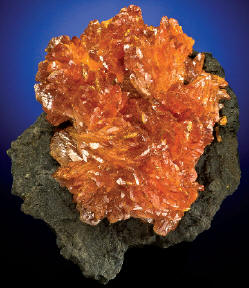
Orpiment on matrix; 10 cm high. J. and Ch. Webb collection. J. Budd photo.
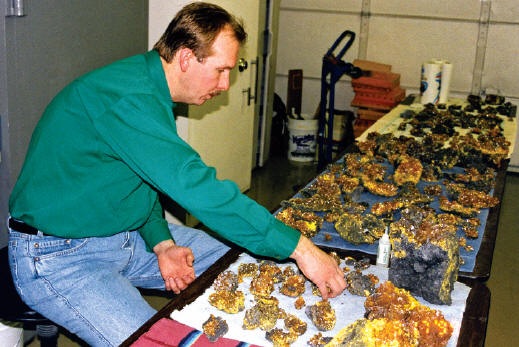
Bryan Lees examining specimens in Collector’s Edge lab. Collector’s Edge photo.
SPECIMEN COLLECTING
Once or twice a day, all mining andcollecting activity in the Mega pit ceased,as workers were evacuated ahead of blasting. The scale of the blasting operationwas impressive, with each blastbreaking over 350,000 tons of rock andconsuming some 60 tons of explosive.
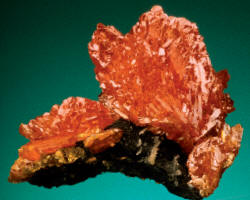
Well formed orpiment crystals on matrix from Cut 20 North zone; 5.2 cm wide. F. Benjamin specimen. J. Scovil photo.
After the blast, roughly 85% of the brokenrock was trucked to the waste dumps, while the remaining 15%, orroughly 45,000 tons, went to the processingplant for gold recovery.
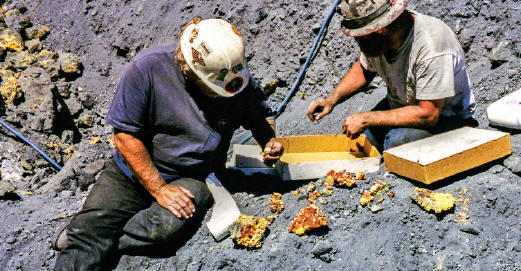
Selecting and packing specimens. Collector’s Edge photo.
Work also resumed in the specimencollecting zones after the blast, with collectorscompleting a ten hour day, beforedriving for one hour back to Winnemuccafor a shower, dinner, and sleep.
Time was of the essence because theNewmont staff went to enormous lengthsto work around the collecting effort andtherefore the Collector’s Edge team dideverything to expedite specimen extractionso that normal gold mining activitiescould resume as quickly as possible. ByOctober 1999, 4000 individual specimenshad been recovered. Amazingly, just two of the collecting campaigns accountedfor some 2000 specimens.
The ideal collecting scenario is onein which specimen material can be removedfrom large, open cavities, unencumberedby pocket bridging. Largepockets are far more likely to yieldplates of crystals with minimal contactdamage. Cut 62 contained a few largecavities that met these ideals, allowingthe recovery of some large, clean andquite outstanding specimens but, unfortunately,most of the largest platesshowed some minor damage.
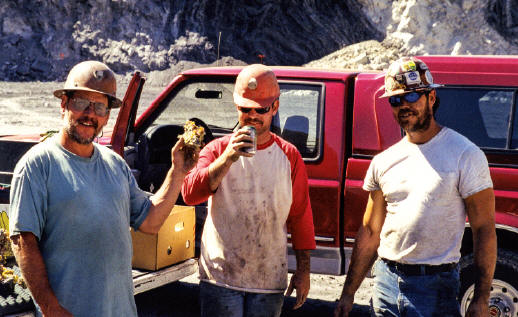
Happy miners resting after after a heavy day. Collector’s Edge photo.
Perhaps the most critical factor determiningthe condition of specimenswas the orientation of pockets relative tothe closest blast hole. Newmont’s miningengineers made every effort to blastaround potential pocket zones, yet someshots still telegraphed into nearby openspaces, and it was the larger open pockets that suffered the most damage. Quiteoften, large pockets (more than onemeter long) were partly collapsed due toblast damage, and it was rare to pull acompletely undamaged, uncontacted orpimentspecimen from anywhere in theMega pit.
Generally, the orpiment pocketswere quite small, averaging 25-30 cmacross, and just 2-8 cm wide. Occasionallya pocket of more than a meteracross, and perhaps 15 cm wide was encountered.

Specimens ready to be trimmed and cleaned in Collector’s Edge lab. Collector’s Edge photo.
Good pocket zones typically comprisedmany pockets clustered togetherand, generally speaking, the more isolatedpockets, up to 30 m away from themain pocket zones, did not contain significantnumbers of specimens. Even thebetter pockets generally produced lessthan ten specimens each, and manyyielded only one. This was common becauseof the narrow pocket dimensionswhich increased the tendency for contactdamage through “pocket bridging” dueto stalactite-like growths from one wall of the pocket to the other. Damage alsooccurred as specimen plates were pulledapart during the collecting process, andas interlocking crystals broke away fromaround the pocket margins.
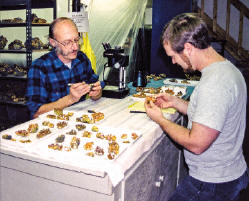
Preparation of the orpiments in the Collector’s Edge lab. Collector’s Edge photo.
Collecting conditions were oftenquite challenging. Weather conditionsranged from snow blizzards in March, tosunny days above 40 degrees Celsius in August, when sunburn and heat exhaustionwere constant threats. The other notabledifficulty was the omnipresentblack, sooty pyrite dust which coatedeverything and everyone as specimenswere being extracted. The build-up ofmud on vehicles was also problematicand, on one occasion, the weight of wetmud on the bottom of the collectingcrew’s 4 by 4 actually ripped out thevehicle’s transmission cables.

Spectacular specimen of orpiment crystals on matrix; 2.4 cm high. Collector’s Edge photo.
On another occasion, a drenchingsummer monsoon left the floor of theMega pit flooded, and the crew wasforced to walk through knee-deep mud to get to the working area. At the end of theday, all specimens, securely packed inbanana boxes, had to be hand-carried inmultiple soggy trips back through thelake. Showers were only partly effective,and crew members had black-stained hands, knees and faces, and workingclothes had to be replaced every fewdays having become irretrievably saturatedwith this sticky black mess.










 YueGongAnBei 44051102000467
YueGongAnBei 44051102000467


 |
|